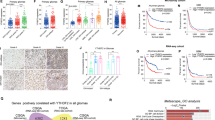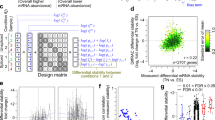Abstract
Regulation of mRNA decay is an important mechanism controlling gene expression. Steady state levels of mRNAs can be markedly altered by changes in the decay rate. The control of mRNA stability depends on sequences in the transcript itself and on RNA-binding proteins that dynamically bind to these sequences. A well characterized sequence motif, which has been shown to be present in many short-lived mRNAs, is the de-stabilizing adenylate/uridylate-rich element (ARE) located at the 3′ untranslated region (3′UTR) of mRNAs. HuR is an RNA-binding protein, which binds to AREs and in doing so, increases the half-life and steady state levels of the corresponding mRNA. Using tissue microarray technology, we found that HuR is over-expressed in human gliomas. We also found that there is a change in HuR localization from being solely in the nucleus to being expressed at high levels in the cytosol. Moreover, a positive correlation was found between total HuR levels, cytosolic localization and tumor grade. We also studied the decay rate of several HuR target mRNAs and found that these mRNAs have a slower rate of decay in glioma cell lines than in astrocytes. Finally, we have been able to decrease both the stability and steady state level of these transcripts in glioma cells using an RNA decoy. More importantly, the decoy transfected cells and cells exposed to a HuR inhibitor have reduced cell growth. In addition, pharmacological inhibition of HuR also resulted in glioma cell growth inhibition. In conclusion, our data suggest that post-transcriptional control abnormalities mediated by HuR are necessary to sustain the rapid growth of this devastating type of cancer.







Similar content being viewed by others
References
Legler JM, Gloeckler Ries LA, Smith MA et al (1999) Brain and other central nervous system cancers: recent trends in incidence and mortality. J Natl Cancer Inst 91:1382–1390
Wrensch M, Minn Y, Chew T et al (2002) Epidemiology of primary brain tumors: current concepts and review of the literature. Neuro Oncol 4:278–299
Rich JN, Bigner DD (2004) Development of novel targeted therapies in the treatment of malignant glioma. Nat Rev Drug Discov 3:430–446
Holland EC (2000) Glioblastoma multiforme: the terminator. Proc Natl Acad Sci USA 97:6242–6244
Moore MJ (2005) From birth to death: the complex lives of eukaryotic mRNAs. Science 309:1514–1518
Wilusz CJ, Wormington M, Peltz SW (2001) The cap-to-tail guide to mRNA turnover. Nat Rev Mol Cell Biol 2:237–246
Perrone-Bizzozero N, Bolognani F (2002) Role of HuD and other RNA-binding proteins in neural development and plasticity. J Neurosci Res 68:121–126
Bolognani F, Perrone-Bizzozero NI (2008) RNA-protein interactions and control of mRNA stability in neurons. J Neurosci Res 86:481–489
Ross J (1995) mRNA stability in mammalian cells. Microbiol Rev 59:423–450
Chen CY, Shyu AB (1995) AU-rich elements: characterization and importance in mRNA degradation. Trends Biochem Sci 20:465–470
Hinman MN, Lou H (2008) Diverse molecular functions of Hu proteins. Cell Mol Life Sci 65:3168–3181
Wang W, Fan J, Yang X et al (2002) AMP-activated kinase regulates cytoplasmic HuR. Mol Cell Biol 22:3425–3436
Peng SS, Chen CY, Xu N, Shyu AB (1998) RNA stabilization by the AU-rich element binding protein, HuR, an ELAV protein. EMBO J 17:3461–3470
Keene JD (2001) Ribonucleoprotein infrastructure regulating the flow of genetic information between the genome and the proteome. Proc Natl Acad Sci USA 98:7018–7024
Dalmau J, Furneaux HM, Gralla RJ, Kris MG, Posner JB (1990) Detection of the anti-Hu antibody in the serum of patients with small cell lung cancer—a quantitative western blot analysis. Ann Neurol 27:544–552
Nabors LB, Gillespie GY, Harkins L, King PH (2001) HuR, a RNA stability factor, is expressed in malignant brain tumors and binds to adenine- and uridine-rich elements within the 3′ untranslated regions of cytokine and angiogenic factor mRNAs. Cancer Res 61:2154–2161
López de Silanes I, Fan J, Yang X et al (2003) Role of the RNA-binding protein HuR in colon carcinogenesis. Oncogene 22:7146–7154
Erkinheimo TL, Lassus H, Sivula A et al (2003) Cytoplasmic HuR expression correlates with poor outcome and with cyclooxygenase 2 expression in serous ovarian carcinoma. Cancer Res 63:7591–7594
Denkert C, Weichert W, Pest S et al (2004) Overexpression of the embryonic-lethal abnormal vision-like protein HuR in ovarian carcinoma is a prognostic factor and is associated with increased cyclooxygenase 2 expression. Cancer Res 64:189–195
Denkert C, Weichert W, Winzer KJ et al (2004) Expression of the ELAV-like protein HuR is associated with higher tumor grade and increased cyclooxygenase-2 expression in human breast carcinoma. Clin Cancer Res 10:5580–5586
Heinonen M, Bono P, Narko K et al (2005) Cytoplasmic HuR expression is a prognostic factor in invasive ductal breast carcinoma. Cancer Res 65:2157–2161
Heinonen M, Fagerholm R, Aaltonen K et al (2007) Prognostic role of HuR in hereditary breast cancer. Clin Cancer Res 13:6959–6963
Mrena J, Wiksten JP, Thiel A et al (2005) Cyclooxygenase-2 is an independent prognostic factor in gastric cancer and its expression is regulated by the messenger RNA stability factor HuR. Clin Cancer Res 11:7362–7368
Denkert C, Koch I, von Keyserlingk N et al (2006) Expression of the ELAV-like protein HuR in human colon cancer: association with tumor stage and cyclooxygenase-2. Mod Pathol 19:1261–1269
Koljonen V, Böhling T, Haglund C, Ristimäki A (2008) Expression of HuR in Merkel cell carcinoma and in normal skin. J Cutan Pathol 35:10–14
Niesporek S, Kristiansen G, Thoma A et al (2008) Expression of the ELAV-like protein HuR in human prostate carcinoma is an indicator of disease relapse an linked to COX-2 expression. Int J Oncol 32:341–347
Sakuma T, Nakagawa T, Ido K, Takeuchi H, Sato K, Kubota T (2008) Expression of vascular endothelial growth factor-A and mRNA stability factor HuR in human meningiomas. J Neurooncol 88:143–155
Wang H, Wang H, Zhang W, Fuller GN (2006) Overexpression of IGFBP5, but not IGFBP3, correlates with the histologic grade of human diffuse glioma: a tissue microarray and immunohistochemical study. Technol Cancer Res Treat 5:195–199
Lehr HA, Mankoff DA, Corwin D, Santeusanio G, Gown A (1997) Application of Photoshop-based image analysis to quantification of hormone receptor expression in breast cancer. J Histochem Cytochem 45:1559–1565
Meisner N-C, Hintersteiner M, Mueller K et al (2007) Identification and mechanistic characterization of low-molecular-weight inhibitors for HuR. Nat Chem Biol 3:508–515
Mazroui R, Di Marco S, Clair E, von Roretz C, Tenenbaum SA, Keene JD, Saleh M, Gallouzi IE (2008) Caspase-mediated cleavage of HuR in the cytoplasm contributes to pp32/PHAP-I regulation of apoptosis. J Cell Biol 180:113–127
Hara A, Okayasu I (2004) Cyclooxygenase-2 and inducible nitric oxide synthase expression in human astrocytic gliomas: correlation with angiogenesis and prognostic significance. Acta Neuropathol 108:43–48
Shono T, Tofilon PJ, Bruner JM, Owolabi O, Lang FF (2001) Cyclooxygenase-2 expression in human gliomas: prognostic significance and molecular correlations. Cancer Res 61:4375–4381
Ma WJ, Cheng S, Campbell C, Wright A, Furneaux H (1996) Cloning and characterization of HuR, a ubiquitously expressed Elav-like protein. J Biol Chem 271:8144–8151
Levy NS, Chung S, Furneaux H, Levy AP (1998) Hypoxic stabilization of vascular endothelial growth factor mRNA by the RNA-binding protein HuR. J Biol Chem 273:6417–6423
Berkman RA, Merrill MJ, Reinhold WC et al (1993) Expression of the vascular permeability factor/vascular endothelial growth factor gene in central nervous system neoplasms. J Clin Invest 91:153–159
Orian JM, Vasilopoulos K, Yoshida S, Kaye AH, Chow CW, Gonzales MF (1992) Overexpression of multiple oncogenes related to histological grade of astrocytic glioma. Br J Cancer 66(1):106–112
Dixon DA, Tolley ND, King PH et al (2001) Altered expression of the mRNA stability factor HuR promotes cyclooxygenase-2 expression in colon cancer cells. J Clin Invest 108:1657–1665
King PH (2000) RNA-binding analyses of HuC and HuD with the VEGF and c-myc 3′-untranslated regions using a novel ELISA-based assay. Nucleic Acids Res 28:E20
Marderosian M, Sharma A, Funk AP et al (2006) Tristetraprolin regulates Cyclin D1 and c-Myc mRNA stability in response to rapamacycinin an Akt-dependent manner via p38 MAPK signaling. Oncogene 25:6277–6290
L’Ecuyer TJ, Tompach PC, Morris E, Fulton AB (1995) Transdifferentiation of chicken embryonic cells into muscle cells by the 3′ untranslated region of muscle tropomyosin. Proc Natl Acad Sci USA 92:7520–7524
Suswam E, Li Y, Zhang X et al (2008) Tristetraprolin down-regulates interleukin-8 and vascular endothelial growth factor in malignant glioma cells. Cancer Res 68:674–682
Sabourin LA, Tamai K, Narang MA, Korneluk RG (1997) Overexpression of 3′-untranslated region of the myotonic dystrophy kinase cDNA inhibits myoblast differentiation in vitro. J Biol Chem 272:29626–29635
Neve RL, Ivins KJ, Tsai KC, Rogers SL, Perrone-Bizzozero NI (1999) Cis-acting regulatory elements in the GAP-43 mRNA 3′-untranslated region can function in trans to suppress endogenous GAP-43 gene expression. Brain Res 65:52–60
Mason CAE, Bigras J-L, O’Blenes SB et al (1999) Gene transfer in utero biologically engineers a patent ductus arteriosus in lambs by arresting fibronectin-dependent neointimal formation. Nat Med 5:176–182
Mallon BS, Macklin WB (2002) Overexpression of the 3′-untranslated region of myelin proteolipid protein mRNA leads to reduced expression of endogenous proteolipid mRNA. Neurochem Res 27:1349–1360
Storbeck CJ, Drmanic S, Daniel K et al (2004) Inhibition of myogenesis in transgenic mice expressing the human DMPK 3′-UTR. Hum Mol Genet 13:589–600
Westmark PR, Shin HC, Westmark CJ, Soltaninassab SR, Reinke EK, Malter JS (2006) Decoy mRNAs reduce beta-amyloid precursor protein mRNA in neuronal cells. Neurobiol Aging 27:787–796
Shir A, Ogris M, Wagner E, Levitzki A (2006) EGF receptor-targeted synthetic double-stranded RNA eliminates glioblastoma, breast cancer, and adenocarcinoma tumors in mice. PloS Med 3:e6
Acknowledgments
We thank Dr. Gregory N. Fuller, M.D. Anderson Cancer Center, Houston, Texas for providing the Tissue Microarrays used in the present studies, and Dr. Martyn A. Sharpe and Ms. Marsha Widmayer for critical reading of the manuscript. Funding for this research was generously provided by: Research Allocation Committee Grant, University of New Mexico School of Medicine and the Childhood Brain Tumor Foundation to FB, and The Henry J.N.Taub Fund for Neurological Research, The Pauline Sterne Wolff Memorial Foundation, Golfers Against Cancer, and the Methodist Hospital Foundation to DSB.
Author information
Authors and Affiliations
Corresponding author
Electronic supplementary material
Below is the link to the electronic supplementary material.
Rights and permissions
About this article
Cite this article
Bolognani, F., Gallani, AI., Sokol, L. et al. mRNA stability alterations mediated by HuR are necessary to sustain the fast growth of glioma cells. J Neurooncol 106, 531–542 (2012). https://doi.org/10.1007/s11060-011-0707-1
Received:
Accepted:
Published:
Issue Date:
DOI: https://doi.org/10.1007/s11060-011-0707-1




